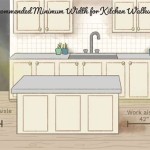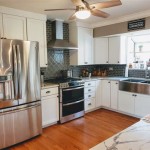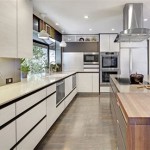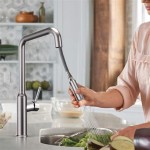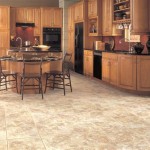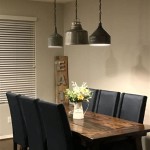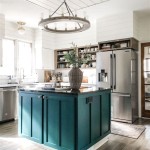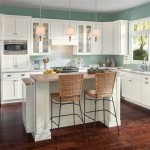How Deep Are Upper Kitchen Cabinets?
Upper kitchen cabinets, also known as wall cabinets, are a crucial component of kitchen design, providing storage space above the countertop. Understanding the standard depth of these cabinets is essential for both designing a new kitchen and replacing existing cabinetry. While there are variations, a common standard exists, influencing the usability and aesthetics of the kitchen space.
The depth of upper kitchen cabinets significantly impacts the functionality of the countertop below. Deeper cabinets can reduce the available workspace, while shallower cabinets might not accommodate larger items. Therefore, understanding and planning for the depth of upper cabinets is integral to creating a functional and visually appealing kitchen.
This exploration will delve into the standard depth of upper kitchen cabinets, the factors that influence variations in depth, and the considerations involved in selecting the appropriate depth for specific kitchen needs. We will examine the impact of cabinet depth on accessibility, storage capacity, and overall kitchen design.
Standard Depth of Upper Kitchen Cabinets
The most common depth for upper kitchen cabinets is 12 inches. This dimension has become a standard for several reasons, primarily balancing storage capacity with accessibility. A 12-inch depth allows for storing standard-sized dinner plates, glassware, and pantry items without protruding excessively into the usable countertop space.
The standardization of this depth also simplifies the design and construction process. Cabinet manufacturers typically produce cabinets in standard sizes, including the 12-inch depth, making it easier for homeowners and contractors to find and install suitable cabinets. This standard has also influenced the dimensions of other kitchen elements, such as countertops and base cabinets, contributing to a cohesive and ergonomic kitchen layout.
While 12 inches is the most common depth, it is important to note that this measurement refers to the exterior depth of the cabinet box. The interior usable space might be slightly less due to the thickness of the cabinet walls and the presence of any hardware or shelving systems.
The term "depth" in relation to cabinets refers to the distance from the front of the cabinet to the back, measured horizontally. This is distinct from the cabinet's height, which is the vertical measurement, and the width, which is the horizontal measurement across the front of the cabinet. All three dimensions are critical when planning a kitchen layout.
Factors Influencing Upper Cabinet Depth Variations
While 12 inches is the standard, variations in upper cabinet depth do exist and are often driven by specific design considerations or functional requirements. Understanding these factors can help homeowners make informed decisions about the best cabinet depth for their individual needs.
One primary factor influencing cabinet depth is the overall kitchen size and layout. In smaller kitchens, shallower cabinets might be preferred to maximize the available countertop space and create a more open feel. Conversely, larger kitchens might benefit from deeper cabinets to provide greater storage capacity.
Another factor is the intended use of the cabinets. If the cabinets are primarily intended for storing small items or decorative objects, a shallower depth might be sufficient. However, if the cabinets are intended for storing larger items, such as mixing bowls or serving platters, a deeper cabinet might be necessary.
Appliance placement also plays a role. For instance, cabinets above a refrigerator are typically deeper than standard to align with the refrigerator's depth. Similarly, cabinets above a microwave might be designed to accommodate the microwave's specific dimensions. These design decisions ensure a seamless and integrated look.
Finally, personal preferences and design aesthetics can influence cabinet depth. Some homeowners prefer a more minimalist look with shallower cabinets, while others prioritize maximum storage capacity and opt for deeper cabinets. Custom cabinet makers can accommodate almost any depth request, allowing for highly personalized kitchen designs.
Some common variations in upper cabinet depth include 15 inches for increased storage and 9 inches or less for specialized applications like above-refrigerator cabinets or open shelving. These variations demonstrate the flexibility available in kitchen design and the importance of considering individual needs and preferences when selecting cabinet dimensions.
Considerations When Choosing Upper Cabinet Depth
Selecting the appropriate upper cabinet depth involves careful consideration of various factors to balance functionality, aesthetics, and ergonomics. Several key considerations can guide the decision-making process.
Accessibility is a crucial factor. Deeper cabinets can make it more difficult to reach items at the back, especially for individuals with limited reach. Shorter individuals might find it challenging to access items in deeper upper cabinets, potentially leading to discomfort or even injury. Therefore, it is important to consider the user's physical abilities when determining cabinet depth.
Countertop workspace is another significant consideration. Deeper upper cabinets reduce the amount of free space on the countertop below, making it more difficult to perform tasks such as food preparation or appliance use. It is important to ensure that the chosen cabinet depth allows for sufficient workspace on the countertop.
The type of items to be stored in the cabinets should also be taken into account. If the cabinets will primarily be used for storing large items, such as pots and pans, a deeper cabinet might be necessary. However, if the cabinets will be used for storing smaller items, such as spices or canned goods, a shallower cabinet might suffice.
Kitchen style and design also play a role. In modern or minimalist kitchens, shallower cabinets are often preferred to create a clean and streamlined look. In more traditional kitchens, deeper cabinets might be used to provide a more substantial and traditional feel. Cabinet depth should complement the overall aesthetic of the kitchen.
The presence of other architectural elements, such as windows or bulkheads, can also influence cabinet depth. Cabinets might need to be shallower or deeper to accommodate these elements and create a harmonious design. Careful planning and consideration of these elements are essential for a successful kitchen renovation.
Finally, budget considerations can play a role. Custom-made cabinets with non-standard depths can be more expensive than standard-sized cabinets. Therefore, it is important to weigh the benefits of custom cabinets against the cost. Weighing custom needs against the standardized offerings will impact the budget during kitchen construction or renovation.
In the end, the ideal depth for upper kitchen cabinets is a balance between these considerations. By carefully evaluating the specific needs of the kitchen and the preferences of the homeowner, it is possible to select a cabinet depth that optimizes functionality, aesthetics, and ergonomics.
Beyond the depth of the cabinet itself, consider the space needed for door swing. Doors that swing outwards require adequate clearance, especially in smaller kitchens. If space is tight, consider alternative door styles like bi-fold or sliding doors, which minimize the footprint of the open cabinet. Another option is to use lift-up doors that swing upwards, eliminating the need for side clearance altogether. This planning step, although not directly related to depth, can significantly impact the usability of the upper cabinets.
The positioning of lighting under the upper cabinets is also affected by their depth. Shallower cabinets may require different lighting solutions than deeper ones to ensure adequate illumination of the countertop. Consider the type of lighting and how it will be mounted when determining the cabinet depth. LED strip lights are a popular choice, offering energy efficiency and a sleek profile that fits well under most cabinet designs.
Finally, remember to consider the weight capacity of the upper cabinets, especially if storing heavy items. Deeper cabinets may encourage storing more items, increasing the load. Ensure that the cabinets are properly installed and reinforced to handle the intended weight. Consult with a professional installer or cabinet maker for advice on weight limits and reinforcement options.

Kitchen Cabinet Depth 2024 Upper Cabinets Dimensions Wall

Icymi Kitchen Cabinet Depth Dimensions Kitchencabinetsdimensions Upper Cabinets Wall

Standard Upper Cabinet Height Conventions And Codes Kitchen Cabinets Measurements Sizes

Kitchen Cabinet Sizes What Are Standard Dimensions Of Cabinets

Kitchen Conundrum Upper Cabinets Open Shelves Or Space Goflatpacks

Get More Kitchen Storage With Counter Depth Upper Cabinets

Kitchen Cabinet Sizes What Are Standard Dimensions Of Cabinets

Standard Kitchen Cabinet Dimensions For Your Homee Design Cafe

Get More Kitchen Storage With Counter Depth Upper Cabinets

How To Decide Between Upper Kitchen Cabinets Open Storage And More
Related Posts

